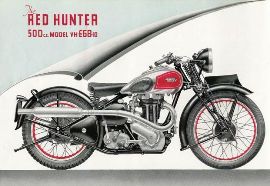THE PRE-WAR YEARS (1925-1939) |
| 1925-1930: |
| Valentine Page, who has been called "Britain's greatest motorcycle designer",
joined Ariel after serving as designer of engines for J.A.Prestwich. Page quickly designed a
replacement engine for the old White and Poppe design. The result was an advanced overhead valve
engine with large valves and a hemispherical combustion chamber. This robust design, updated and modified, remained
in production through 1958 and is familiar to all owners of Ariel singles. The new engine was developed over
the next couple years and by 1927 was mated to redesigned cycle parts including a saddle gas tank and larger
internally expanding brakes. The redesign inspired a new prancing horse logo and a new slogan - "The Modern Motorcycle". |
| The Val Page designed Ariels from this era - 1926 through about 1930 - have been dubbed the "Black Ariels"
due to their standard gloss black finish and to contrast them with the wider range of designs
and colors offered later. After 1930 Ariel began to offer sloping engines, 4 valve engines and even an OHC four cylinder
alongside their standard designs. |

|

|
| Val Page 1950s |
Late 20s Ariel with Page designed engine. |
|
| In 1929 Jack Sangster hired Edward Turner, a young engineer who had been trying to sell
his idea for a 4 cylinder motorcycle engine. Turner's engine was essentially a pair of parallel twins mated front to back
on a common crankcase and connected through geared flywheels. The result was four cylinders in a box configuration - the square four.
After some redesign and development the resulting Ariel Square Four was ready to show. |

|

|

|
| Edward Turner at Ariel |
Two early OHC Sq4s |
|
1930-1939: |
| The Ariel Square Four caused a huge sensation when launched at the Olympia Motorcycle Show in 1930. Enough was thought of it that in 1931, it's first year
of production, a privately owned Square Four was fitted with a supercharger and entered in the Isle of Man TT. Unfortunately it did not finish the race. The first Sq4
production models were 500cc but 600cc versions went into production for 1932. These early engines had a chain driven overhead camshaft, but by 1937 they were superseded
by 1000cc pushrod engine - the Model 4G. Despite it's unusual cylinder layout the square four engine remained in production through the 1950s. The final version of the
Square Four was the all alloy Mk II, produced from 1953 to the end of Ariel 4-stroke production in 1958. When it entered production the only British motorcycles of comparable
displacement were the V-twin Brough Superior and the HRD Vincent; Square Four production outlasted them both. |
|
|
| The first Red Hunter appeared in 1932, coded VH32. It featured a tuned four–overhead valve 498cc vertical cylinder VG. The series
soon included the 250cc and 350cc models. The red tank panels on chrome gas tank with red wheel rim centers made it a sporting and beautiful sports
bike. It must have been quite a bright spot during the height of the Great Depression. |
| But the depression was unforgiving and the same year, 1932, Components Ltd., Ariel's parent company, ran into financial trouble and closed shop for a short period. The director's son, Jack Sangster,
bought all of the tools and re-hired the best of Ariel's staff, then moved 500 yards down the road to a new factory. The skeletal remains of the company were restructured as Ariel Motors Ltd.
Val Page left to work for Triumph and Edward Turner became technical director of Ariel Motors. |

|

|
| Early Red Hunter |
1939 sales brochure |
|
| In 1933 the wide diversity of Ariel designs was trimmed down to fewer standard designs. The exceptions were the continued
production of the Square Four and the addition of flashy upswept pipes and lots of chrome to the sporting Red Hunter. The Red Hunter was not
just flash, it was also a competitive bike. Through the 1930s the Red Hunter was to Ariel what the Gold Star would become to BSA, a leader in
competitive races which resulted in commercial success and popularity. Len Heath won the Scottish Six Days Trial in 1933 on an Ariel Single.
Heath was still winning on Ariels when in 1938 he took second in the same event on another Red Hunter. |

|

|
| Scottish Six Days Trial team. |
International Six Days Trial winners. |
|
| 1938 saw the introduction of enclosed valve gear for the OHV singles and 1939 saw the introduction of an optional rear suspension.
The suspension was designed by Frank Anstey and incorporated a link that traveled through a short arc so that the drive chain tension was kept
constant during compression and rebound. This "Anstey Link" rear suspension was to remain in production for use on the Sq4s through 1958. |
|
|
| While up-grades for civilian models were being developed, Europe was preparing for war. Ariel submitted a design for a 350 single
with a modified frame to the War Department for evaluation. When Hitler attacked Poland in September 1939 Ariel production was switched to satisfying
War Department orders for military motorcycles. Production of civilian motorcycles ceased and the last civilian models were sold off in early 1940.
The workers at Ariel would devote the next 5 years to war production. |
| Back to Ariel History |